Last updated: 27 April 2006
|
Last updated: 27 April 2006 |
Subject: 494 y lpi Sent: Monday, April 24, 2006 21:08:48 From: Manuel Saez (manuelcarlossaez@yahoo.com) Sorry my english. I read several information about the lpi and 494.... but somethin i dont understand yet. With a ds114 controlled by 494 (a laptop Win XP....... i can take images with a LPI ? (this funtion particulary) if yes.... with wich wire?? 505 or 506? Or i cant take pictures with a ds114?? Thanks a lot Manuel SAEZ, San Antonio Venezuela.Mike here: You need an Autostar #497 and not the #494 to use with the Autostar Suite software if you want to have Autostar control.
And:
Thanks Mike. now another question..... The 497 autostar work with the ds114?? or work with any telescope motorized that use 494?? Thanks again!! Manuel SAEZMike here: As you can see on Meade's Autostar page (http://www.meade.com/support/auto.html), yes, the #497 works with all DS models.
Subject: Re: Afocal vs. LPI on ETX 105 UHTC Sent: Monday, April 17, 2006 06:18:31 From: Christopher Lucas (chris.lucas@yahoo.com) Thanks, Mike. You raise some good points that I hadn't considered (particularly with regards to post-processing). Think I'll stick with the LPI for the time being and upgrade to a DSI later this year.
Subject: Meade LPI pics of Jupiter Sent: Monday, April 17, 2006 05:09:25 From: jcaggiano@mindspring.com (jcaggiano@mindspring.com) What's up? I was able to snap a pic of Jupiter early Sunday, April 16. There was a weird blue tinge to it though, despite the fact that it was clear and transparent out. I can only think that the blueness is caused by turbulence in the atmosphere allowing only the blue spectrum to come through as interpreted by the LPI. The pic is semi-decent and has some detail to it. I remeber that the pic I sent in 2 weeks ago had the same problem earlier on in the evening. As the night progressed, the color lost the blueness and became more brownish red. Have you ever heard of someone having this same problem? Processed through Registax in order to cutback on the blue scale and boost up the red scale on the RGB. Shot through a 6" newt, 2x barlow and of course the Meade LPI. Thanks for posting and keep up the excellent site. Joe Caggiano

Subject: Meade Lunar Planetary Imager Sent: Saturday, April 15, 2006 22:47:50 From: Kim Miau Lee (robin051@gmail.com) I own a Meade LPI. I would like to ask whether it's capable of using the drizzle technology? If it can, does it mean that I can take astrophoto under altazimuth alignment? Thanks in advance for your reply! Regards.Mike here: The current Autostar Suite software supports Drizzle with the LPI. The LPI has always been able to be used in Alt/Az mode.
And:
I would like to thank you first before I start my reply! Is Drizzle seemed to be useful if I just do short exposure?Mike here: Yes.
Subject: Meade LPI camera problems Sent: Saturday, April 15, 2006 15:59:49 From: Luke Berryman (luke_b_berryman@yahoo.co.uk) First off, congratulations on building a really helpful and useful website! I'd please like to ask for some of your advice. I'm quite new to astronomy (I've owned a Meade ETX 70, my first telescope, for about 6 months now), so I still feel that I'm finding my way with most of it. As I've always been quite keen on photography anyway, astrophotography was a prospect which intrigued me. I was thinking about simply buying a mount for a camera but, with the reported difficulties of such a method, I decided I'd go for something a bit more hi-tech. I didn't feel that it would be good to start with one of the 'pro' Deep Sky Imaging CCD kits, so I went for a (Meade) LPI instead. I'm having real difficulties using it. The first night out, I managed to take some great photos of the moon. However, whenever I move the telescope to another area of the sky to take images of anything - be it a planet, star, galaxy or whatever - all I get on the LPI tracking screen on the PC is static/noise. I never get a discernable image. Indeed, the camera doesn't seem to pick up anything at all, save the moon; I once put my hand over the end of the scope to see if it would register, and the pattern of the noise on the screen remained the same. It seems unlikely to me that the camera is broken (why would it take images of the moon and nothing else?). The instructions that came with it (this seems to be an irritating common-factor in most Meade products!!) don't contain a troubleshooting section, and don't mention any difficulties that might occur when trying to examine anything other than the moon. I've tried fiddling with the telescope's focus, the exposure, the constrast, brightness, hue, etc, but nothing seems to make any difference whatsoever. I'm slightly concerned that it might have to do with the apparant incompatibility with Windows XP - Meade say that it's fine to install the programme, but my computer automatically advised against it. Do you think that this might have something to do with it? Any help at all that you're able to give would be really appreciated. I just want to get out there and build up a collection of astrophotos! Best wishes, and keep up the great work on your site! Yours sincerely, -Luke Berryman (Oxford, England).Mike here: If you get images of the Moon then the LPI and software are likely working correctly. However, for fainter objects like planets, you will need MUCH longer exposures. I suspect that is the problem you have. However, I am concerned by your comment on the installation: "my computer automatically advised against it". What did you mean by that? Also, while it can image brighter DSOs, the LPI is named "Lunar Planetary Imager" for a reason and is best suited for those objects.
And:
Thanks a lot for the advice, I really appreciate it. As soon as the clouds have cleared up I'll try a longer exposure with Jupiter and see what happens. My computer advised against installing the LPI programme because it appears that, strictly speaking, the Autostar Suite isn't compatible with Windows XP (though it is with Windows 98). The leaflet that came with the LPI said that Windows XP might automatically try to reject Autostar, but to ignore this as Meade were confident that Autostar matched the requirements of Windows XP (I'll dig this leaflet out and send their exact wording to you). Also, my problems are compounded by the fact that the instructions which came with the LPI are actually for the DSI - I guess they're similar in most areas though. Another question I have emerges from Meade programmes apparently being slightly behind the progress of Windows. I really want to connect my telescope to the computer so that I can control it from there (it's a laptop). The Meade instructions say that I must do this via a Comm Port. However, my laptop doesn't have one and, according to a computer technician I asked, Comm Ports are quite an old feature not found on most new computers nowadays. Do you know of any way that the ETX can be connected to a laptop without a Comm Port? Once again, many thanks for all your help. Best wishes -LukeMike here: You will need a USB-serial adapter but not all work reliably with the Autostar. See the article "Autostar and USB" on the Helpful Information: Autostar Info page.
Subject: Some more LPI Images Sent: Friday, April 14, 2006 10:52:54 From: jcaggiano@mindspring.com Just wanted to say thanks for having a great site. I enjoy visiting and comparing my photos and methods to other people's methods out there. I have enclosed some more shots of Jupiter and sunspots from earlier this month. The first shot is sunspot group 865 & 866 from April 2. The shot was taken with the LPI, a 2x barlow and a solar filter through my 6" Newt. Next is Jupiter from April 2. Both shots were with the LPI and a 2x barlow through the 6" scope. Also is included a shot of 3 of Jupiter's moons. Taken the same way on April 2 with alittle bit of processing to bring the moons out better. From bottom left to top right the moons are : Ganymede, Io and Europa. More to come as soon as I get some clear skies. Joe



Here's a shot of Saturn on April 9, 2006 taken through my 6" newt with the Meade LPI and a 2x barlow. Processing was done through Registax 3.0.1.9 and PhotoEd. I slowed the scope down to f/10 with the barlow. Seeing was a 7 out of 10.

Subject: Meade LPI with ETX105 Sent: Monday, April 10, 2006 09:56:01 From: Dave Miller (djomiller@sympatico.ca) Last night this seeing was quite good and I think I topped my best Saturn output. Quality was set to 85% and exposure 0.5 sec - collected 102 images. I also attached a couple Moon pictures that I think you will like. Thanks for your great site!! Dave



Subject: Lunar Shots with the Meade LPI Sent: Monday, April 10, 2006 07:48:44 From: jcaggiano@mindspring.com (jcaggiano@mindspring.com) Here are a couple of shots of the Moon taken with the LPI. They are all single exposures (no stacking). The first was done early February 2006. It's a shot of the Lunar Appenines. Archimedes is visible just to the left center of the photo. Plato is also visible at the very top of the pic. Photo taken through my Orion 6" Astroview EQ with the Meade LPI, A variable polarizing filter (adding a blue hue to the pic) and a 2x barlow for 250x (f/10). Second Pic done a few days later of Copernicus. Taken with my Orion 6" Astroview EQ, a Meade LPI, a VPF and a 2x barlow for 250x (f/10). Final shot is a set of 2 mosaics, each one a mosaic of 3 shots of the moon at different phases. Taken early January over a period of 2 nights. Shot through an Orion 6" Astroview EQ, a meade LPI and a VPF.
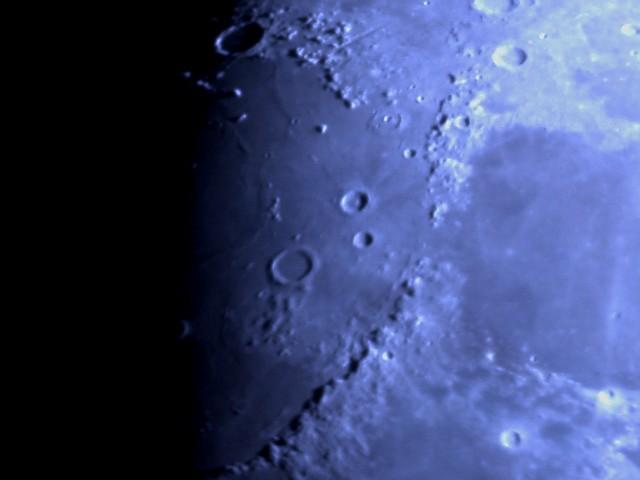


Subject: Afocal vs. LPI on ETX 105 UHTC Sent: Monday, April 10, 2006 07:42:06 From: Christopher Lucas (chris.lucas@yahoo.com) First of all, thanks for creating and maintaining such a valuable resource for the ETX community. I have an ETX105 w/UHTC and am just starting out with astrophotography. Currently, I'm using an LPI with some satisfactory results, but am wondering how LPI results would compare with afocal imaging using my Nikon 7900 and something along the lines of a Scopetronix adapter and Maxview eyepiece. Would I be better off saving my lemonade stand money :) and getting a DSI? DSI II and Pro versions are bit beyond budget, but I'm looking for best bang for the buck (acknowledging I still have some work to do on my technique). Attaching two recent samples of my LPI images: Moon (Tycho region) - taken on 04/09 -- single frame LPI. Saturn - taken on 04/09. 35 frames post-processed using Registax. Thanks in advance. Chris
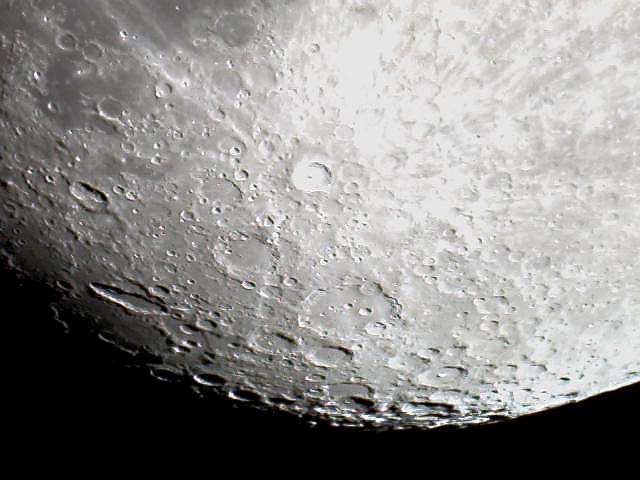

Subject: improved pictures of the moon. And a Saturn. Sent: Saturday, April 8, 2006 08:47:33 From: Hellen Ruijmgaart (hmruimgaard@versatel.nl) On april fifth 2006 i took some images of the moon under bad conditions here in Holland. (it was like the moon was beeing cooked in my microwave!). I used my etx 125 with uhtc and the lpi and 2x barlow lens to obtain the images. I'm still a novice when it comes to the lpi with autostar suite end processing images with registax and photoshop cs2 but i'm very pleased with the final results under these terrible conditions. I'm very curious what kind of images i can get with a 3x barlow and a steady atmosphere... For all the images i used the unsharp mask and the reduce noise function in Photoshop. I also played with the contrast and brightness levels. I hope you can post some of my pictures... I'll send them one by one(just read your email etiquette ;-). Best regards, Jeroen Oosterhof, the Netherlands.
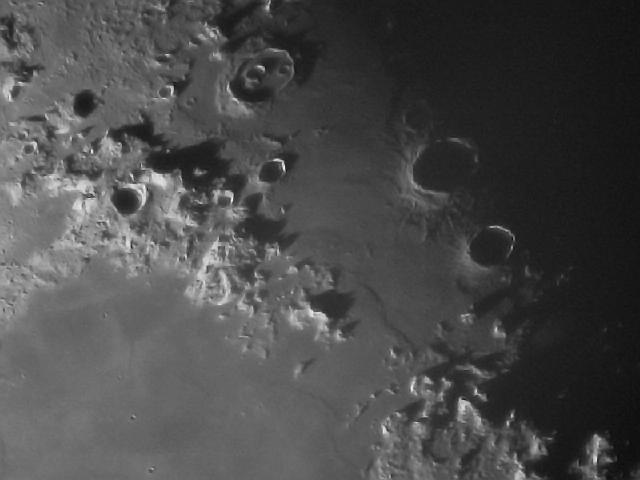
This was my best picture of the session. A beautiful shot with from top to bottom, the Aristoteles, Eudoxus, Calippus and right of Montes caucasus the cassini crater. I think the Montes caucasus comes out beautiful with its structure...

Another picture taken with th 2X barlow. Here you can see from top to bottom, the Vallis Alpes(valley), the cassini, aristillus and Autolycus crater as well as the Montes caucasus(mountains).

This is a overview shot taken without the barlow.

This is a shot of the Fernelius, Stofler, Faraday and maurolycus craters taken with the 2X barlow.
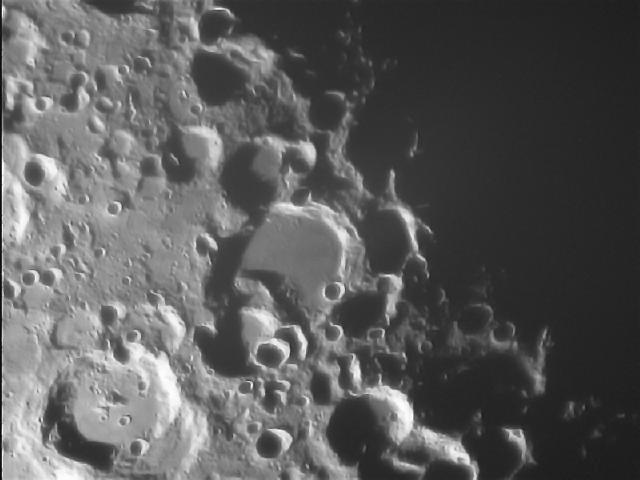
This is a shot of the damaged circular formation albategnius taken with the 2X barlow. The dimension of the crater is 82x82 miles...

another crater formation shot... I forgot to say that i took the pictures from my street in Amsterdam. I took them from my balcony(hope i spelled that right) from the 4th floor. And the setup was alt/azimuth. I have to figure out how to polar align though, i read on your site that a polar align provides much better tracking and better images...

The last picture i send you is a picture of saturn i made on the fifth of april from my fourth floor balcony in amsterdam under bad conditions. It was taken with the ETX125 with uhtc and 2X barlow on a alt/azimuth setup. with the half moon nearby. I never seem to get color images of saturn though. Sometimes it's white and bright, sometimes purple or orange. I played around with the exposure, offset, gain and histogram settings of the lpi imager program without results. Do you have any idea how to get better results? Thanks in advance and for putting together this much needed website! Still saving for your book ;-) will get it soon! Best regards, Jeroen Oosterhof, the Netherlands.
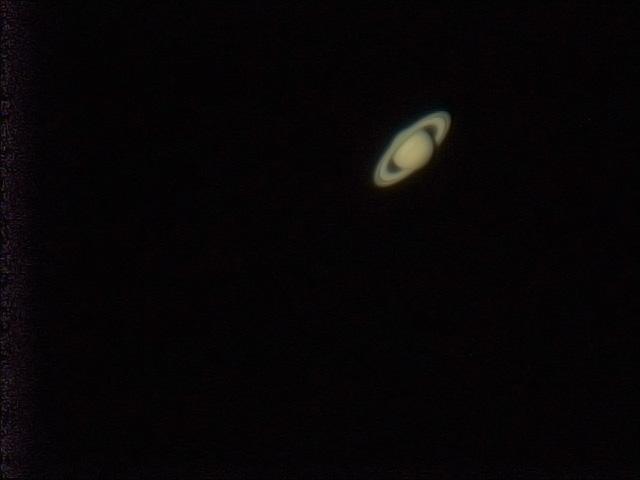
Thanks for your comment mike, i really appreciate that. Actually, your site challenges me to get the best images i can get ;-) it will be pretty cool to see my pictures on your site! That's what i'm doing it for ;-) And thanks for your quick response on my "saturn" question. I'll will reduce the exposure next time. Still hoping for a steady atmosphere... Clear skies! Best regards, Jeroen.
Subject: Meade LPI shots Sent: Friday, April 7, 2006 04:58:29 From: jcaggiano@mindspring.com (jcaggiano@mindspring.com) I am not sure if you still update your webpage about the LPI. If you do, here are some pics I took with the LPI. First one is Jupiter taken on April 2, 2006 at around 1:00 AM EST. It is the best 7 images set at 90% minimum quality. Conditions were perfect. I got the GRS "front & centered" in this shot. Second shot is Saturn taken MArch 29 around 8:00 PM EST. Conditions were near perfect. Best of 6 images stacked at 80% minimum quality. Both shots were taken through my Orion 6" Astroview EQ with a 2x barlow.

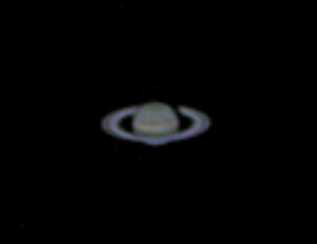
Subject: Need Help with Meade LPI Sent: Tuesday, March 28, 2006 08:53:29 From: jcaggiano@mindspring.com (jcaggiano@mindspring.com) Hi. I have been reading your posts on the LPI and DSI and enjoy seeing the pics ppl are taking. I have a favor to ask. I am having a problem with the Meade LPI. I finally got it to work after downloading a new web browser, an update for the LPI found at the Meade site and a 23 mb upgrade for the .Net Framework file. Before I had performed all this stuff, over the past few months I have been taking pics with the LPI using a different driver. A driver I had loaded into my PC for a Dynex webcam picked up the Meade LPI and I was able to take pics that way. Using this method I can understand why my pics thus far have been mediocre (on Jupiter and Saturn). Last night I got a really clear night in the Philadelphia region. I was very excited to FINALLY use the LPI the way it was supposed to be used. I was very dissapointed to see that even using the Meade driver, and stacking the images and tweaking the histogram and using the Magic Eye ect...... Nothing made my pictures come out better than what I was already doing before. I thought for SURE I would have picked up some detail on Saturn. The planet itself showed ZERO detail as well as the rings showing no divisions whatsoever. My question is "What am I doing wrong"? How come I am picking up no detial? I thought Meade's Autostar Suite was supposed to stack the images automatically. Do I need to use a filter on the camera to cut down the glare? I have tried this before with every possible combination of contrast boosters, variable polarizers ect....Nothing (and I mean NOTHING) brings out any detail in the rings. Please help. Below is a single shot (not stacked) of Saturn on the last clear night. This was taken using my old Dynex driver that happened to pick up the meade LPI camera b/c I had not yet downloaded the .Net Framework files. This pic was processed using the Historgram and some other tweaks in Registax. Though the brightness is cut down about 50%, NO detail can be seen. I thought for sure this would have ended when I upgraded the Meade files. ALL my shots of Saturn are exactly the same. No detail in the rings. No detail in the cloud belts. I am using a 6" Reflector (Orion). I have seen ppl with smaller scopes get MUCH better pics. I know at least a few of the nights I have been out have been near perfect conditions and through binoviewers, I have seen the Cassinni Division as well as 2 cloud belts. How come I can't produce a pic to show that. Please help. Thanks in advance. Joe Caggiano

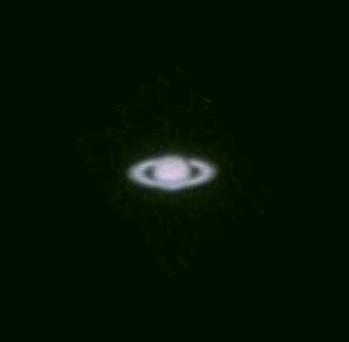
Subject: The Moon Sent: Monday, April 3, 2006 05:18:18 From: Lubomr Janoatiak, ml (lubomir.janostiak.ml@zoznam.sk) It is The Moon - 3. 4. 2006 My first CAMERA MEADE LPI!!! :-)
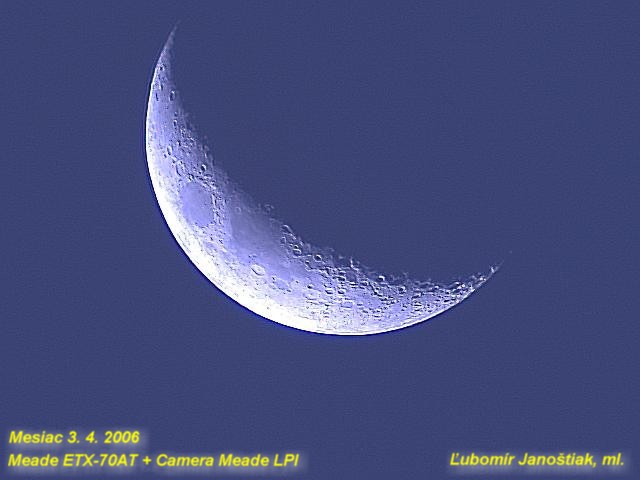
Subject: New to the MEade ETX Family Sent: Saturday, April 1, 2006 17:22:27 From: chris (chris.detroia@gmail.com) I wanted to thank you for having such an informative site. It is an excellent source of information for both the beginner like me to the well seasoned individual. I recently purchased a used Meade ETX-125 and have found a whole new experience to explore. Attached are a few pictures that I was able to take using the Meade ETX 125 and the LPI of Saturn and the Moon. I hope they are able to find their way to you postings. Thank you, Chris West Palm Beach Florida



Subject: SOLAR ECLIPSE FROM GREECE Sent: Wednesday, March 29, 2006 22:40:09 From: John Kalantzis (acent4@vol.forthnet.gr) I send you this set of 29 / 3 / 2006 solar eclipse shots from Volos - Greece. The magnitude of the eclipse in Volos was 81,3%. I got them with MEADE LPI Imager and 400mm Kenlock telephoto customized on the LXD 55 telescope mount.

Subject: LPI Image of Saturn Sent: Tuesday, March 28, 2006 23:30:36 From: millers18@att.net (millers18@att.net) The night sky finally cleared up on March 15 2006 so I got out my ETX 125, popped in some new batteries from the 99 cent store and set up to image Saturn with the LPI. The scope tracked well in polar alignment mode and the LPI performed flawlessly as usual. The temperature dropped from 52 degrees to 42 degrees over the imaging session, and when I noticed Jupiter rising in the east I thought I would try my luck imaging Jupiter. But alas! The cold sapped all the life out of the cheap batteries (I should know better than to use cheap batteries... the motors groaned and the Autostar displayed a Motor Fault on its screen. I will probably have to recalibrate the scope the next time I use it.) Attached to this e-mail is one of the best shots of the night. It was taken with my ETX 125 UHTC, Meade LPI and a Parks apochromatic 2X Barlow. The image is a composite of approximately 100 stacked images with the quality threshold set to 75. The contrast was enhanced slightly with Adobe Photoshop. Taken from Spring Valley, California on the night of March 15-16, 2006. Hope you find the image suitable for posting on your site. Sincerely, Brian Miller Spring Valley, California

Subject: Meade ETX problems with LPI Sent: Sunday, March 26, 2006 22:39:41 From: Terry Willis (iszum2@ec.rr.com) Thanks for taking the time to develop your web site for the ETX. I have found it as informative if not more so than Meade's web site especially when it comes to the LPI. Just got into the stars as of January 2006 and shortly thereafter purchased Meade's LPI to go along with my ETX80. As a beginner I am overwhelmed with the beauty that has always been "out there" and I didn't take the time to look at. Wanted to capture it in photographs so I got the LPI. Must say that I thus far am dissappointed with it. The instruction manual Meade provides with the LPI is not very informative. It gets you on the playing field but doesn't do much beyond that. The program continually locks up my laptop and I can't seem to find the right settings to get a "live" screen of any stars. Can't even get Sirius to screen up. No problem with the "bright" moon or daytime terrestrial objects, but stars have been out of the question (nothing but a black screen which may or may not be "live" depending on if the program locks up or not without warning). I realize that it is probably something I'm not doing right (being a beginner) but I can't find the answer to the problem. Meade is behind the times with no email in customer support and an answering machine on the customer service help line. I've read your email responses and find that others are complaining of the same problem over the past three years. My LPI moon shots and bird photos (for my wife, the bird watcher) are fantastic. The LPI seems to be a good buy with the exception of the lock up flaw and operations manual. Hopefully Meade will get it straight and let the rest of us know about it. I am attaching a moon shot taken from eastern North Carolina in March 2006. equipment: Meade ETX80AT with Meade LPI. single frame photo Thanks Terry

Subject: Emailing: m42.jpg Sent: Sunday, March 19, 2006 05:59:55 From: alex wilson (esraguin@btinternet.com) Took this pic of m42 trapezium with my lpi on my lxd55 sc8in 68 frames combined 5.7sec exposures mono very happy with result, Hoping to get the best out of the lpi in the future, Is there any benefit cooling the lpi, my scope is outside in my shed pier mounted so the lpi is always cold . Alex M Wilson CLINTERTY OBSERVATORIES SCOTLAND

Subject: EXT 105 Help
Sent: Sunday, March 19, 2006 02:52:20
From: Dan Krszal (dankrszal@comcast.com)
got a question for u, I just got my 105 about a week ago and it seens to
be ok, than i got a lpi for taking pictures, well when i connect it i
kept gettting a picture fadeing in and out well I thought and call meade
to an ask then and they seen t think it was the lpi, well that was 2
days ago didn't sent it back yet goin gto monday, going to get something
better , but now tonight I wwas looking at the moon, and it was fading
in and out and I couldn't get a sharp fix on it, well i would and then
it would fade out and back in with out touching anything, Well now I am
thinking that the lpi aw something that i didn't. Any Idea what it
might be? Before I go and sent it back, I had a meade EXT 80 and it had
a problem and sent it back then I said why now just get something better
and I did, well at this point it looks like i might have to sent it back
to and get another one if u don't know what it might be, what really
sux's it that when i sent th e80 back I had then 2 day it back to me so
I wouldn't have to be without a telescope in case there was a nice
night. well I am goin g to sent the LPI back for sure but if it is
someting i am doing wrong withthe 105 I don't want to sent it back and I
thought I would ask u first then meade then sent it back if i have to.
II would even call u Ld if u could tell me what to do if it was to hard
to tell me over the internet. just leave # and I would call u. but if u
can tell me over email well that is find for me just do say well dan its
bad and it has to go back. Haha
Thanks
Dan
Mike here: Not exactly certain what the problem could be with the LPI but there are some possibilities. if the USB port you connected it to doesn't supply enough power then the LPI might do that. If the "fading" is really just the autoexposure in the software trying to compensate then you can try a shorter exposure value. For the Moon you need really short values. Or the LPI could be bad.
Subject: Trapezium and Saturn Sent: Thursday, March 16, 2006 13:40:01 From: Jan H Kolst (jan.kolsto@online.no) This pics were recently (March 2006)taken from Haugesund ,Norway.Any suggestions for improvement?


Subject: Re: first light photo's with etx125 and meade lpi Sent: Thursday, March 9, 2006 07:02:34 From: hellen ruijmgaart (hmruimgaard@versatel.nl) Thanks a million times Mike! When i first looked at all those stunning images from everyone, i could only hope to make such beautiful photo's and now you put me up there among them. Taking photo's with the lpi was easier then i expected. But it's that easy due to the perfect optics of the ETX125! It's a wonderful machine and I'm completely sucked into this new hobby! Hopefully It will not destroy my relationship ;-) Ps; keep up the good work Mike! Regards, Jeroen Oosterhof.
Subject: AW: LPI Saturn Sent: Thursday, March 9, 2006 02:10:44 From: Paul Fleissner (Paul.F@chello.at) Oh sorry, I forgot to write the model. I used the ETX 125 UHTC with a 2x Barlow. I took the picture from my balcony located nearly in the centre of Vienna. The ETX really is mighty! -----Ursprngliche Nachricht----- Von: Mike Weasner [mailto:etx@me.com] What model telescope was used?
Subject: first light photo's with etx125 and meade lpi Sent: Monday, March 6, 2006 06:15:26 From: Hellen Ruijmgaart (hmruimgaard@versatel.nl) Two weeks ago i bought a meade etx 125(my first scope)after i read tons of articles and reviews from your website. Yesterday i made some pictures with the supplied lpi webcam i live in amsterdam, the netherlands and the seeing was lousy but i had to make some pictures. I hope you can put one or two photo's in the gallery. By the way, the site is great, without it i would be propably lost... in space... ps; Is there a way to reduce the focal length of the lpi so that i can make pictures of the whole moon? Thanx in advance, Jeroen Oosterhof, the Netherlands



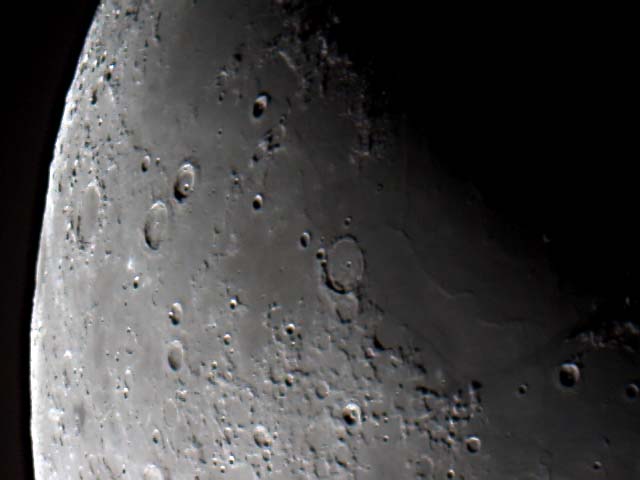

And:
Thanks for your reply and for posting my pictures, that's pretty cool! when i have some extra money (purchasing the ETX 125 was quite an investment) I will buy your book. I am a newbie to this amazing and absorbing hobby so your book will be a valuable item! Thanks again! Jeroen Oosterhof, The Netherlands.Mike here: Just found out that Meade has released a SCT adapter for the rear port that allows their SCT focal reducers to be used. Here's a link:
And:
wow, you're faster than Lucky Luke! Thanks for the link Mike, I will check it out. Have a nice day. Clear skies! Jeroen.
Subject: LPI Saturn Sent: Sunday, March 5, 2006 23:15:57 From: Paul Fleissner (Paul.F@chello.at) This picture was taken on the 2nd of march at about 7.30 pm in Vienna, Austria. The sky cleared for just 2 hours and I got my chance. Taken with the LPI in the old LPI program and a little processed using PSP. I had not so good results using envisage. I used a total of 50 Frames. Hope the weather gets better soon. Best regards Paul Fleissner

Subject: Saturn Sent: Friday, March 3, 2006 18:20:09 From: Richard Anderson (andersonhomes@comcast.net) Pic of Saturn using LPI Imager and ETC 125. I have a question, should I be getting better images than this? My scope was purchased used? R Anderson

Return to the top of this page.
Go to the January-February 2006 LPI Page.
Go to the October-December 2005 LPI Page.
Go to the July-September 2005 LPI Page.
Go to the May-June 2005 LPI Page.
Go to the March-April 2005 LPI Page.
Go to the January-February 2005 LPI Page.
Go to the October-December 2004 LPI Page.
Go to the July-September 2004 LPI Page.
Go to the April-June 2004 LPI Page.
Go to the January-March 2004 LPI Page.
Go to the 2003 LPI Page.
Go back to the Astrophotography Page.
Go back to my ETX Home Page.